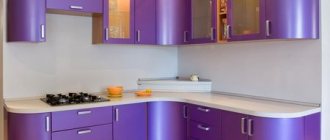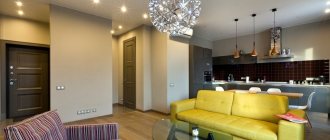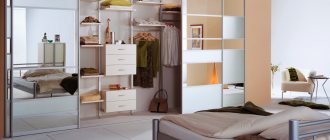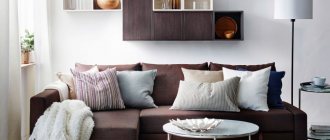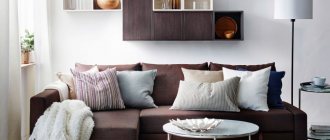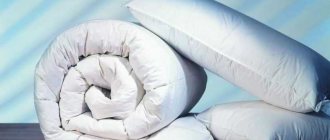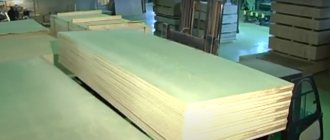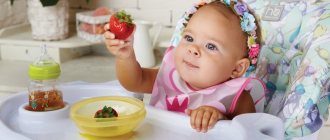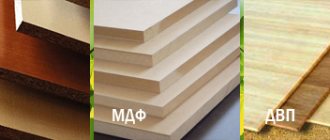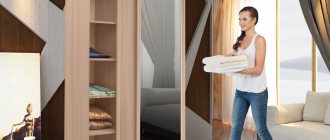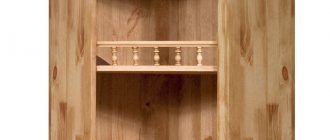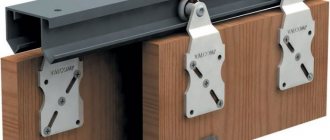Photo: www.elvis-mebel.ru
“Sometimes product variety is bad...” sighs visitors to a hardware store who have to choose between similar board materials such as MDF, chipboard and laminated chipboard. At the same time, it is completely unclear to a non-professional which of the above can be used in a particular case. But figuring it out is not as difficult as it seems. MDF (short for Medium Density Fiberboard) is a type of medium-density fiberboard created by dry pressing (at a certain high pressure and temperature) of fine wood chips. It is clear that no matter how much the raw material is heated or compressed in this case, the chips will not stick to each other. Therefore, a “binder” (something like glue) is added to them - urea resins modified by melamine. The MDF production technology was developed in the USA in the 60s of the twentieth century, and its industrial production began there in 1966. In Russia, the first MDFs were produced only in 1997. Chipboard - chipboard (usually referred to as chipboard, although it is correct to use the abbreviation DSTP) - is obtained by hot pressing of chips (and other wood particles) mixed with a non-mineral binder. In this case, chipboard can consist of either one layer or several layers (three or more). Chipboard has been produced in the USA for more than 70 years, in Russia - somewhat less.
Photo: www.makuha.ru
LDSP is a type of chipboard, which is a board laminated with melamine films. The unity of the design is achieved by simultaneous exposure to high temperature and pressure. The surface of laminated chipboard can be made either smooth or embossed (imitating the structure of wood or any other materials).
How to choose material depending on the room
To correctly determine the material for making interior items for different rooms, you need to take into account some recommendations.
Each variety is created for its own purposes, so to unequivocally state that some material is better or worse is completely wrong
Furniture in the hallway
This is a room with high traffic and changes in temperature and humidity. Water carried in from the street can create problems. Therefore, for furniture in this room there are the following rules:
The standard economy option involves the use of products made entirely of laminated chipboard. But all external edges are processed with 2 mm PVC edge, and internal edges with 0.4 mm. An alternative for some areas may be printed edging.
Particular attention is paid to racks directly located on the floor: they are additionally raised above the surface using special “boots”
Melamine and thin (up to 1 mm) PVC or ABC tape is considered an unreliable option, it is used only for processing internal surfaces, the outer edge is treated with an edge of 2 mm, while the highest protection is provided by PVC and aluminum moldings under the milled groove
A better solution involves combining materials. For facades, MDF is used, where in the frame version HDF is suitable for insertion. The body is made of laminated chipboard with maximum edge processing.
A box assembled from laminated chipboard and decorated with an MDF facade significantly reduces the price of the headset, without losing quality in operation or appearance
Kitchen set
Although medium-density fiberboard is the optimal solution for high humidity environments, it is not used for all kitchen items. Therefore, when they say that a product is made of MDF, it means exclusively the facades or the top of the dining table.
For the kitchen, the same rules apply as for the hallway, but there are additional nuances:
- The tabletop set must be moisture resistant. This protective impregnation is clearly visible on the cut: most often it gives the structure a greenish tint.
- It is better to abandon chipboard facades with melamine edges. It is easy to distinguish: the surface feels like very thick paper. The best solution is to process it with 0.4 or 2 mm PVC tape. The last option has slightly rounded corners.
The ends of objects located next to the stove must be covered with a special aluminum cover. The hanging elements are positioned to minimize the ingress of steam.
In kitchen sets, it is not so important whether the facade is made of MDF or laminated chipboard, the main thing is to choose a good countertop and provide protection from moisture in the floor area
Children's room and bedroom
Furniture for a child’s room (as for any other premises) must have mandatory certification. But unlike previous objects, children's beds can be made entirely from MDF
Particular attention is paid to the internal stiffeners on which the mattress flooring is located: such parts are made of wooden beams, providing the necessary strength and reliability
Both MDF and laminated chipboard are widely used for the production of children's furniture; in this case, it is not so much the material that is important, but the level of trust in the brand
The remaining pieces of furniture should be as functional as possible. They are subject to the following requirements:
- For children under 6–7 years old, it is better to choose products with rounded edges, which is inherent in milled parts with a wood-fiber structure, or equip them with special pads.
- The fittings should be selected with smooth closing of the facades, which will prevent injuries.
Furniture for the bedroom and walls in the living room is selected based on personal preferences, but the best solution would be a combination of MDF and laminated chipboard.
Comparison of materials
To determine the difference between the slabs, it is necessary to consider a number of factors:
- Environmental friendliness. There is an opinion that only wood-fiber products can be used for furniture production, since they are environmentally friendly. In fact, all varieties produced in large quantities contain a certain percentage of binder resins that are toxic, but their concentration does not exceed the norm.
- Wear resistance. Determining the most durable material is not always easy, since all varieties tolerate mechanical loads well, but are deformed when subjected to point impact.
- Resistance to humidity. If we compare MDF and laminated chipboard in this parameter, the first option will be the undisputed favorite. Furniture for bathrooms and shower rooms is made from medium-density boards. But properly treated laminated chipboard parts can also withstand fluctuations in humidity.
The quality of MDF panels is certainly higher, but in furniture sets these characteristics are not always in demand, especially when it comes to dry heated rooms, so sales of laminated chipboard and MDF are at the same level. A
negative attitude towards products made from laminated chipboard arises due to the fact that in the furniture market Low quality products are present in large volumes. It is mainly produced in private workshops, where, to reduce the cost of production, low-density slabs are used and the fittings are distributed without taking into account technology.
Presence of a pungent odor
First of all, furniture should not have a sharp, pronounced chemical odor, which appears when low-quality laminated chipboard is used
After all, it is important for all of us to be surrounded by environmentally friendly pieces of furniture.
For residential premises, it is allowed to use laminated chipboards marked E1; if the value E2 and higher is indicated, such material cannot be used for the manufacture of furniture. A pungent odor characterizes a low-quality slab that contains formaldehyde levels that are exceeded. This will affect the health of all family members; not only headaches, but also serious disorders in the human body can become constant companions.
Permissible formaldehyde content for CIS countries: 10 mg per 100 g of slab. In Europe, the requirements are stricter: 8 mg per 100 g of chipboard
The smell in products appears when the formaldehyde content is from 14 mg per 100 g of plate
MDF or chipboard. What's better?
MDF and chipboard have been arguing with each other for a very long time. Here it is impossible to say unequivocally what it is better to order a cabinet from and indicate the winner and loser. After all, everything depends on each specific case: the goal (what do you want to buy?), the purpose (which room and who will use it?), the budget (the amount that you included in your personal estimate marked “for furniture”?) and, of course as well as wishes for appearance (what should the future product look like?).
Both materials have long been successfully used in construction and interior decoration. We are interested in their march through the furniture market.
Mr.Doors uses both MDF and chipboard in its collections, giving you the opportunity to decide for yourself which material to choose. But you don’t have to choose! They combine and match perfectly with each other. We'll talk about their differences further.
MDF – Medium Density Fiberboard. This is the Russian version of the English term. The transliteration is "medium density fibreboard". MDF production is structured as follows: fine wood chips (process chips) are pressed under high pressure and temperature. Only natural substances are used as a binding component: lingin (wood resin) or paraffin.
Already from the description of the production process it becomes clear that the main advantage of MDF is environmental friendliness. And indeed it is! During operation, MDF does not emit any impurities harmful to humans and animals. This is a durable furniture wood material that at the same time has high density. Thanks to this, the plate securely holds the fastening fittings and the holes do not crumble. MDF is easy to process. It can be used to make curved facades and perform figured milling (panels), which not every material can boast of.
MDF has an amazingly huge number of processing options: PVC films of any color and texture, high-gloss films and enamels, finishing with veneer and solid natural wood. Believe me, this is a lot! Even the most demanding buyer will find what he is looking for.
MDF loses to chipboard in cost, and loses seriously. This can be called its only serious disadvantage. But this is completely justified, since MDF will last you much longer and will look like it was just bought.
Chipboard is a chipboard, the raw materials for which are sawdust, shavings, and dust. In the case of chipboard, formaldehyde resins act as a binding component. Chipboard is widely used in furniture and shows its good sides. Of course, if it meets high quality standards.
We would like to draw your attention to the edge. Chipboard is safe only in one case: if it is efficiently and seamlessly laminated (coated with film)! Only under this condition can you sleep peacefully, without fear for your health and the health of your loved ones
Mr.Doors cannot afford to use materials hazardous to health, so our assortment contains only high-quality E1 class chipboard. This is the standard at which formaldehyde emissions are the lowest. E1 class chipboard is recommended for use in the production of furniture for children's institutions.
Chipboard usually has a laminate finish. There are also quite a lot of colors and textures. The main competitive advantage of chipboard as a material is its cost. At the same time, he looks more than presentable.
Disadvantages and advantages of materials
Advantages of laminated particle board:
- Wide range of colors, textures, wood imitation.
- Resistant to mechanical stress.
- Does not deteriorate when exposed to high temperatures .
- Affordable price .
- It is destroyed when exposed to auxiliary tools, so precise processing is impossible .
- Releases formaldehyde resins that are part of chipboard.
Wood fine board (MDF) has the following advantages:
- Ecologically pure .
- Fine can be carried out .
- More affordable than solid wood.
- Long service life.
Cons: the domestic market is just beginning to develop in this direction, so the cost is an order of magnitude higher .
MDF and laminated chipboard: what is the difference
The composition of particle board (chipboard) includes compressed shavings and sawdust impregnated with formaldehyde resins. Depending on the grade, chipboard has different quality characteristics: from a loose material with a density of 300 kg/m3 to a more durable and expensive one with a density of 600 kg/m3, which is precisely used in the manufacture of furniture.
Modern production makes it possible to minimize the harmful effects of the binder resin and improve the appearance of the slab by coating it with melamine film - lamination. Hence the name “chipboard”. The film has good aesthetic properties and does not allow formaldehyde to evaporate.
The production of MDF boards takes place using improved chipboard production technology - by drying wood fiber and hot pressing. Medium Density Fiberboard (MDF) contains only the finest sawdust, compressed to a homogeneous state. Unlike chipboard, which must be thoroughly sanded before covering with film,
MDF immediately has a smooth and even surface. This board is denser and more durable, resistant to drilling and moisture compared to laminated chipboard. It is also better suited for deep milling and deformation when creating radius furniture facades. In addition, MDF board has significantly higher environmental properties due to the fact that mainly natural resins, lignin and paraffin are used as sawdust impregnation. Formaldehyde is also present, but in much smaller quantities.
To make the differences between the two materials more clear, you can compare the structure of chipboard with a heterogeneous raw material passed through a blender, and MDF with a product from a meat grinder. The density of MDF board varies from 600 to 800 kg/m3, which in conditions of high moisture allows the material to surpass even natural wood in some characteristics.
Caring for laminated chipboard or MDF furniture
There are several general conditions for caring for furniture made from MDF or laminated chipboard.
- Prolonged exposure to high temperatures is undesirable: at 75 degrees and above, peeling of the coating is possible.
- Another factor is sunlight, which can also change the appearance of the slab. Film on laminated chipboard is more susceptible to fading, although MDF may change color somewhat with constant exposure to sunlight.
- You also need to be careful about long-term interaction with water. If the joints of the coating are not sealed, when water gets inside the slab, the sawdust will swell, and the slab itself will lose its appearance and properties. However, this is an extreme case. Under normal household conditions, with short-term exposure to water, which is inevitable in the kitchen, the stove can retain its original appearance for a long time. MDF manufacturers claim that fiberboard can withstand even a small flood.
Chipboard or MDF: which is better?
The common advantage of both materials compared to natural wood is resistance to pests and fungal infection.
Advantages and disadvantages of MDF:
Chipboard and MDF: combining materials
The best option for your wallet, without sacrificing quality and durability, is to choose furniture with a combination of materials.
Laminated chipboard will perfectly fulfill its functions as the basis for the kitchen body, and MDF, thanks to the variety of films for coating and the possibility of decoration, will allow you to make beautiful facades that will fit perfectly into the interior of the kitchen. So you shouldn’t choose what’s better for the kitchen: MDF or chipboard? The answer lies in the correct combination of both materials and their rational purpose.
For example, laminated chipboard, in addition to being used in furniture, can be used as an inexpensive, but durable and reliable tabletop of various thicknesses: from 25 to 38 mm. The plate is covered with multilayer plastic using Postforming technology. This slab is resistant to moisture and mechanical damage, so it will last for many years without requiring special care.
High-quality laminated chipboard in combination with MDF can also be used in the production of other furniture, including wardrobes, beds, and furniture groups for a children's room. If the joints and connections of laminated chipboard are reliably protected, and the manufacturer has appropriate certificates confirming the environmental friendliness of the material, then such furniture is safe to use and can deservedly take its place in the apartment.
Chipboard production technology
During the production of wood products, more than 50% of waste remains in the form of shavings. It is these wood chips that go into the production of chipboards, along with other parts of wood that are not suitable for making anything (knots, sticks, thin branches).
Until the time Max Himmelheber offered his innovation to the world, all these remnants had to be disposed of. Now they are collected in drying chambers, and after complete drying they are processed by a cyclic unit, which grinds the dried raw materials to a homogeneous state.
Afterwards, a formaldehyde binder - resin - is added to the dry sawdust, and cold pressing begins on a conveyor to create the required shape. The layers obtained in this way - blanks - must be glued together using a hot press.
The finished sheets are cooled (fan units are used for this); dry well; after which they can be given the necessary shapes and dimensions on sawing and milling machines.
Safety
The production technology of board materials implies that MDF contains less harmful substances than chipboard. We are talking about volatile substances released by resins (used as binders), harmful to humans, which gradually (during long-term operation) “evaporate” and accumulate in the air if there is no sufficient ventilation of the room. All these substances do not cause immediate damage to the human body and have a harmful effect only with prolonged contact with them (in other words, if you decide to lie on a chipboard or MDF board for a long time, you will die not from poisoning with the substances they secrete, but from thirst, hunger or from old age).
However, manufacturers still established a certain gradation:
- MDF - with strict adherence to technology and high-quality cladding of surfaces, structures made from it are considered the least dangerous in terms of the release of harmful substances into the surrounding air. In the production of MDF, the main binder is lignin, released during the heating of wood. Therefore, high-quality MDF is environmentally friendly;
— E1 class chipboard – ranks second in terms of safety for the human body (but also only with appropriate surface cladding);
— Class E2 chipboard – emits the largest amount of harmful substances, is prohibited for production in foreign countries, and in Russia it is prohibited for the production of furniture and products used inside public and residential premises (GOST 10632-2007).
The difficulty of determining the harm actually caused by these materials is that the information recorded in the certificates is not always true (and sometimes the certificates attached to the materials are not “original” ones, that is, compiled based on the results of tests, but “purchased ones”). In addition, not all manufacturers (especially Russian ones) follow the recommended process technology for the production of MDF and chipboard, trying to save money by using lower quality resins.
Price
The simpler the production and the more accessible the raw materials, the cheaper the material will be. Since the main raw material for the production of MDF and chipboard is waste from the woodworking industry, the difference in price will be influenced by the following factors: - production technology (MDF is more expensive than chipboard), - country of origin (board materials from foreign European companies will cost more than theirs) Russian analogues), - the number of intermediaries between the manufacturer and the buyer (the more there are, the more expensive the material will end up), - the presence of additional properties imparted to the materials during the production process (fire resistance, bioresistance, water resistance), - availability, quality and durability decorative coating on MDF or chipboard (everything that makes a structure made from these materials more safe and durable costs more).
MDF or chipboard. What's best for children?
When choosing a children's room, we are, of course, concerned about the safety and environmental friendliness of future furniture. Of course, a lot depends on the character of the child and the period for which you purchase furniture. For a long time or, for example, until the moment when the child goes to gnaw on the granite of science.
If you have a hooligan boy growing up who conducts experiments on everything he sees, then MDF is your option. And if you have a gentle and neat excellent student growing up, then you may well make a choice in favor of chipboard.
Visit any of our Mr.Doors furniture showrooms with your children! We guarantee that you will experience a lot of positive emotions and get an answer to every question you have! You will be pleasantly pleased with professionalism, willingness to help, individual approach and high-quality service.
The kitchen has an elusive atmosphere of comfort and the warmth of a home. It is she who gathers all household members within its walls every day: in the kitchen, adults and children meet to have a snack and share news. How to make the interior of this room as cozy and comfortable as possible?
A dressing room is not just the dream of most women, but also the most comfortable form of storing clothes. In most modern apartments, a small dressing room is already included in the layout. However, if your home initially does not have a separate storage room, you can create a small dressing room yourself by separating part of the room with a stationary or sliding partition.
Creating an interior design for a small children's room is a difficult task. After all, every parent wants to give their child the best. However, if the room is small, this is clearly not easy to do. How to place everything you need in a small nursery? Leave enough free space for games and active activities? Create a cozy atmosphere? You will find answers to these questions in our article.
Difference between panels
Despite the popularity of both types of slabs, each of them occupies its own niche in the furniture business. The materials differ:
By density
- MDF is a dense and moisture-resistant material. Its structure is strong and lends itself to fine processing. Used in carved cabinets, headboards and other places where grace and fine lines are required. Products made from MDF are durable and massive.
- Laminated chipboard is a loose material that strongly attracts moisture. It has a durable façade surface, but is inferior to MDF in terms of fracture strength. The material suffers in the fastening areas due to frequent disassembly and assembly or dragging of pieces of furniture. Laminated chipboard is 2 times inferior in strength to fibreboard. At the same time, the laminated protection makes the chip structure stronger, while at the same time protecting it from moisture and temperature. Therefore, laminated chipboards are popular in the manufacture of kitchen sets and bathroom furniture.
Environmentally friendly
- MDF is close to wood in nature and is allowed for all premises.
- Laminated chipboard contains toxic components (formaldehyde), which limits its use in areas where children and patients are present.
By design
- The design of MDF panels is limited.
- Laminated chipboard has many colors and textures due to the laminated coating. Chipboard panels are used to make cabinet furniture with an imitation of any wood.
By cost
- MDF is expensive. Used in the manufacture of luxury furniture.
- The price of laminated chipboard is more affordable. The facades of economy-class cabinet furniture are mainly assembled from laminated boards.
Main types of chipboard
Chipboards are classified according to various criteria.
Based on the concentration of harmful substances, categories E1 and E2 are distinguished:
- E1 is the least dangerous type and indicates minimal evaporation of formaldehyde substances. This class of chipboard is recommended for use in residential premises, including children's rooms.
- E2 is the most toxic, but cheaper material, applicable in large rooms with good ventilation. However, in most countries it is already prohibited for production due to its non-environmental friendliness.
According to external indicators and quality of raw materials:
- 1st grade: made from shavings of one type of wood (oak, pine, beech...). These are even, smooth slabs that are covered with veneer, a special film or laminated. Used for cabinet furniture and its facades.
- 2nd grade: these are usually slabs using 1st grade technology with technical defects - unevenness, chips, scratches, and other damage.
- 3rd grade: these are uncoated slabs with many defects, often used for temporary structures such as formwork.
By type of finish:
- veneered - the chipboard panel is covered with a thin sheet, which is made of natural wood and has a beautiful wood structure;
- laminated - protective varnish or melamine film is applied to the chipboard sheet;
- rough - panels for temporary, technical needs that do not have a decorative coating.
How to choose material depending on the room
To correctly determine the material for making interior items for different rooms, you need to take into account some recommendations.
Each variety is created for its own purposes, so to unequivocally state that some material is better or worse is completely wrong
Furniture in the hallway
This is a room with high traffic and changes in temperature and humidity. Water carried in from the street can create problems. Therefore, for furniture in this room there are the following rules:
The standard economy option involves the use of products made entirely of laminated chipboard. But all external edges are processed with 2 mm PVC edge, and internal edges with 0.4 mm. An alternative for some areas may be printed edging.
Particular attention is paid to racks directly located on the floor: they are additionally raised above the surface using special “boots”
Melamine and thin (up to 1 mm) PVC or ABC tape is considered an unreliable option, it is used only for processing internal surfaces, the outer edge is treated with an edge of 2 mm, while the highest protection is provided by PVC and aluminum moldings under the milled groove
A better solution involves combining materials. For facades, MDF is used, where in the frame version HDF is suitable for insertion. The body is made of laminated chipboard with maximum edge processing.
On a note! If the lower ends are not protected, they can be additionally coated with silicone sealant.
A box assembled from laminated chipboard and decorated with an MDF facade significantly reduces the price of the headset, without losing quality in operation or appearance
Kitchen set
Although medium-density fiberboard is the optimal solution for high humidity environments, it is not used for all kitchen items. Therefore, when they say that a product is made of MDF, it means exclusively the facades or the top of the dining table.
For the kitchen, the same rules apply as for the hallway, but there are additional nuances:
- The tabletop set must be moisture resistant. This protective impregnation is clearly visible on the cut: most often it gives the structure a greenish tint.
An ordinary laminated chipboard sheet is not suitable for a tabletop; such a board must be thicker and denser than the façade material and have a higher moisture protection class
It is better to abandon chipboard facades with melamine edges. It is easy to distinguish: the surface feels like very thick paper. The best solution is to process it with 0.4 or 2 mm PVC tape. The last option has slightly rounded corners.
The ends of objects located next to the stove must be covered with a special aluminum cover. The hanging elements are positioned to minimize the ingress of steam.
In kitchen sets, it is not so important whether the facade is made of MDF or laminated chipboard, the main thing is to choose a good countertop and provide protection from moisture in the floor area
Children's room and bedroom
Furniture for a child’s room (as for any other premises) must have mandatory certification. But unlike previous objects, children's beds can be made entirely from MDF
Particular attention is paid to the internal stiffeners on which the mattress flooring is located: such parts are made of wooden beams, providing the necessary strength and reliability
Both MDF and laminated chipboard are widely used for the production of children's furniture; in this case, it is not so much the material that is important, but the level of trust in the brand
The remaining pieces of furniture should be as functional as possible. They are subject to the following requirements:
- For children under 6–7 years old, it is better to choose products with rounded edges, which is inherent in milled parts with a wood-fiber structure, or equip them with special pads.
- The fittings should be selected with smooth closing of the facades, which will prevent injuries.
Furniture for the bedroom and walls in the living room is selected based on personal preferences, but the best solution would be a combination of MDF and laminated chipboard.
Features of laminated chipboard (chipboard)
LDSP is a well-known chipboard coated with a facing film. The technology for manufacturing such boards has been known for a long time; in the 80–90s, furniture made from chipboard was one of the most popular.
Later, obvious shortcomings were identified, which somewhat reduced the popularity of this material. At the same time, a simple chipboard has fewer advantages than its counterpart with a laminating film on top of the board.
Advantages of the material
- different sheet thickness;
- high hardness;
- widest choice of colors;
- good tolerance to humidity and high temperatures.
Furniture made from laminated chipboard has long proven itself. Many are satisfied with the price-quality ratio, as well as the long service life and ease of maintenance.
Disadvantages of laminated chipboard
One of the most critical disadvantages of laminated chipboard is toxicity. When making this type of particle board, formaldehyde resins are added to the mixture before pressing, which ensures adhesion and rigidity.
When purchasing furniture made from chipboard, you should pay attention to the class of the material. The E1 indicator indicates less toxicity of the components
At the same time, it is always worth studying the quality of lamination of joints - they should be covered or covered with special corners made of plastic, rubber or metal.
In addition to the toxic effects due to poor-quality assembly or damage to the laminating film, there is another disadvantage. It is not so significant; for some this disadvantage does not even matter. Due to the high hardness of the material, it is impossible to create relief patterns on the surface using milling machines. Instead of a beautiful relief, chips will appear on it, so the surface remains simply smooth. It is possible to create a slight imitation of the relief structure of wood or stone through the use of a special plastic film.
Major chipboard manufacturers on the market
The production of laminated chipboard is a profitable business for many companies. On the market you can find material of domestic and foreign origin.
Color solutions, quality and cost are very different. It is worth talking about industry leaders in order to navigate the assortment and choose the most profitable product option.
Active in the market since 1961. Branches in Russia are a subsidiary of BAZIK, the main production is located in Austria. The company produces laminated chipboards according to European standards. The manufacturer can offer a wide selection of colors, coniferous wood products without additives and reasonable prices.
It is possible to get European quality at Russian prices. The company has representative offices in 7 European countries and is not going to stop at the heights it has achieved.
Laminated chipboard from the brand "LAMARTY"
Lamarti is a plywood factory in Syktyvkar with a line of laminated chipboards in 120 decorative options. The brand constantly updates its collections, which allows you to choose both classic shades of material and find something exclusive.
For the production of raw materials, the latest generation equipment is used, all lamination processes are automated.
Compared to foreign analogues, Lamarti is a golden mean with affordable prices and high quality products.
The line of this brand has the following advantages:
- Wear resistance;
- Strength;
- Large assortment of colors.
It is not recommended to buy this type of chipboard for bathroom furniture or rooms with high humidity.
Lamartie is inferior to the same Egger by 2 times. Representatives of the furniture company conducted an experiment in which samples of Lamartie and Egger were immersed in a container of water to a depth of 3 cm. The duration of the experiment was 3 hours.
As a result, the Lamartie sample was saturated with water to 8 cm, while the Egger impregnation remained at the immersion level.
Brand Kronospan
The Kronospan company operates in 24 countries around the world and markets a wide range of chipboards. The brand's products are distinguished by antistatic characteristics, a large selection of shades and durability.
The advantages of laminated chipboard from Kronospan include:
- Increased resistance to humidity. You can buy furniture made from this material for the kitchen or bathroom, and it will not lose its aesthetics over time;
- Strength. Disassembly and assembly of furniture is allowed up to 5 times without deformation of the holes for the fittings;
- Furniture service life is up to 20 years;
- Environmental friendliness. The content of harmful substances in the composition is not higher than the lower threshold of the permitted norm;
- Affordable prices.
Laminated chipboard from the Kronospan brand is used for the production of various types of kitchen sets. The formaldehyde content in the material is no more than 10 mg.
High quality, safety, design are the three main requirements that the manufacturer places on its products.
laminated chipboard from
This is a domestic company with affordable prices, a large product line and quality certificates. Branded products are cheaper than their European counterparts, but their characteristics are no worse.
Users consider the main advantages of the material:
- Resistance to mechanical damage and scratches;
- Resistance to humidity. Furniture made from this material can be freely purchased for the kitchen or bathroom;
- Large palette of colors. You can choose the shade of the slab that suits you best for the project;
- The material holds fasteners well when assembling furniture and is less likely to deform;
- Affordable price.
Laminated chipboard furniture from Nevsky Laminate lasts no less than its analogues.
Chipboard "Swiss Krono"
Swiss Krono is a domestic company with a plant in the city of Sharya. The brand offers a large range of materials from classic tones to fantasy shades and exclusive decor.
The brand offers customers:
- 13 types of structures and hundreds of shades of products;
- Certificates of conformity and authenticity for goods;
- The content of harmful substances is within normal limits;
- Long service life;
- Execution of individual orders of exclusive type.
The brand is not as well known on the market as Egger or Lamarti, but this manufacturer should not be discounted. The company's assortment includes decent types of furniture materials.
Laminated chipboard from the BYSPAN brand
- manufacturer of furniture materials from Belarus. The brand is engaged in the production of chipboards, laminated chipboards, and cutting materials according to specified requests.
You can order the required amount of material with delivery. Delivery of an order from Belarus is sometimes cheaper than purchasing goods in Europe or from individual domestic companies.
The brand offers its customers:
- Low content of harmful substances in products;
- Quality control of production and product line without defects;
- More than 120 types of wood shades, different chipboard structures;
- Affordable prices. The cost of goods is much lower than in Europe.
What is better for kitchen furniture? How are these materials different?
At first glance, it is difficult to understand how MDF differs from chipboard. Experienced people can immediately see the differences, but beginners, even after several years of use, cannot guess the difference. The undeniable advantage of the first is its environmental friendliness, which determines high operational safety, although the cost of the material also dictates its own rules. If you have the financial means, you should choose furniture made entirely from MDF for your bedroom and children’s room.
The ability of laminated chipboard to withstand high levels of indoor humidity has made it a frequent companion in bathrooms and kitchens. It is difficult to imagine more suitable inexpensive furniture for these rooms. At the same time, with poorly laminated joints, chipboard tends to absorb moisture. In order for such furniture to serve for a long time, you need to carefully inspect all ends of the product. At the same time, this allows you to make sure that furniture made from chipboard is safe for use.
If the cost of MDF were comparable to the price of laminated chipboard, then the choice would be obvious - fine wood fraction. This is not yet the case - laminated chipboard is cheaper than its competitor, which determines its demand among consumers.
Combinability of materials
Many will not be able to determine whether it is laminated chipboard or MDF by appearance. The visual differences between them are understandable only to experienced people. If the product has a clear rectangular shape without relief and angled ends, then even professionals who know the difference between MDF and laminated chipboard will not immediately identify the differences.
This approach to combining materials allows you to use the aesthetic characteristics of the fine wood fraction without spending a lot of money. From the point of view of operational safety, everything remains the same - chipboards must be protected from chips.
What it is?
MDF got its name from the English abbreviation MDF, which translated into Russian means “finely dispersed fraction”. Explanation LDSP - laminated chipboards. Materials are manufactured using different technologies, which is why they have different properties.
laminated chipboard
This is a regular particle board (chipboard) covered with a laminated film. The main raw material for its production is waste from wood processing enterprises. It can be:
- crooked trunks;
- knots;
- branches;
- trimmings generated during the process of sawing logs and trimming lumber.
The wood is cleared of bark and fed to grinding units, for example, rotary knife grinders. This is how shavings are made. Its average thickness is 0.5 mm, width is no more than 5 mm, and length is about 40 mm.
During the production process, the chips are dried in special chambers and then calibrated. After preparation, the raw materials are fed into mixers that operate continuously. There it is mixed with binders. The next stage is the entry of the viscous mass into the molding equipment, which forms a 1-3-layer carpet. It goes to pressing. When compressing the workpiece, a pressure of 40 kg/cm3 and a temperature of up to 220 degrees are applied.
The slabs formed and dried in this way enter the cooling chambers. After this, the edges of the material are aligned and cut to the specified dimensions. Particle boards are sanded, making them even and smooth.
The next stage is lamination. It is performed in a certain sequence:
- gluing 1-2 layers of paper onto the base (the first should have a maximum thickness of approximately 0.5 - 1 mm, so that in the future it will be possible to press the design);
- laying a layer of transparent paper and mixed resinous substances;
- applying the main layer to the chipboard slab and pressing it with a stamp with a pattern; gluing the decorative layer is done in the same way;
- gluing with a stamp a protective layer that protects the product from various contaminants.
When exposed to high pressure and temperature, the film reliably adheres to the board, forming a durable laminated coating.
MDF
For the production of MDF boards, the raw materials are prepared in the same way as for the production of laminated chipboards.
- Wood chips are made from wood waste and dried to a moisture content of 9%.
- Next, it enters special cyclones, where large chips are sifted out due to air separation.
- The calibrated chips are heated and pressed under high pressure.
- In the process, due to the strong heating of wood fibers, natural resins (lignin) are released. Thanks to these substances, the chips are firmly glued to each other.
- The MDF boards obtained after pressing are cooled and ground to give a smooth surface.
- After this, the products undergo further processing - they are sanded, laminated or varnished.
Manufacturers also produce more expensive material – veneered. It involves gluing a thin layer of natural wood onto the surface of the slabs.
Differences
What is the difference? A facade based on chipboard for a kitchen is less profitable than MDF.
MDF facades are:
- painted;
- with plastic coating.
A veneered façade is an MDF base coated with a thin layer of wood from the catalog and coated with varnish, matte or glossy.
In terms of technical characteristics, it is inferior to a painted facade, but at the same cost. It is necessary to apply veneer on both sides. In this case, its technical dimensions are preserved.
What is chipboard?
Explanation of the abbreviation chipboard - chipboard. It is made as follows:
- They take shavings and chips formed as a result of wood production at sawmills. The starting raw materials are coniferous and deciduous trees of low value.
- Production waste is passed through special crushers.
- The resulting particles are compressed at high temperature. The smallest chips go to the top layer.
- Substances of non-mineral origin – phenol-formaldehyde resins – are used as an adhesive base. At the same stage, fire retardants, antiseptics and other components are added to the slab, which provide protection against fungus, parasites and improve the characteristics of the finished material: making it stronger, more resistant to moisture and fire.
Covering the board with a film of melamine resin is called lamination. This is how laminated chipboard is obtained. More expensive products are additionally varnished. Compared to regular chipboard, laminated board looks better, has higher strength and water resistance.
The demand for furniture made from chipboard and laminated chipboard is still high due to the low price and wide selection of colors. A big plus of the material is its resistance to high temperatures. However, it has a number of serious disadvantages:
Emission (release) of formaldehyde.
Formaldehyde is a gas with a pungent odor and high toxicity. Its content in laminated chipboard can reach up to 18%. It has carcinogenic properties, irritates mucous membranes (and for this reason is especially harmful to the eyes and respiratory organs), and can cause allergic reactions.
There are classes of chipboard E0.5, E1 and E2 depending on the quantitative content of formaldehyde. Laminate makes wood board more environmentally friendly by preventing the evaporation of toxic gas, although it does not completely solve the problem.
Low density
Laminated chipboard easily crumbles and cracks due to mechanical stress, therefore it is suitable for the manufacture of only cabinets and straight furniture facades. You cannot screw a self-tapping screw into the same place twice. The material does not hold hammered nails, glass
If handled carelessly, you can accidentally pull the handle out of a cabinet door or drawer.
Rabies
The outer surface of laminated chipboard is resistant to moisture, but the risk of water penetration through side cuts, chips and gaps remains. This leads to an increase in the volume of material by 20-30%. The laminate cracks, and the appearance of the chipboard deteriorates. It is highly not recommended to use the material for bathroom furniture.
Advantages and disadvantages
Despite the fact that MDF is the leader in the positions discussed above, chipboards still occupy a larger segment of the furniture market. The main advantage of particle boards is their low price, so manufacturers continue to make cabinets from this material, thereby reducing the cost of finished cabinets. Often there are combined furniture options, when the body is made of chipboard and the facades are made of MDF. This solution allows us to produce headsets with an improved design, making them more affordable for most consumers.
The advantages of chipboard include:
- availability of choice;
- pliability to rough machining;
- relative moisture resistance;
- sound and heat insulation properties.
- formaldehyde resins cause health problems;
- “open” ends contribute to the saturation of the slabs with moisture and the subsequent destruction of their structure;
- re-screwing the screws is not possible;
- fine decorative processing cannot be performed due to the friability of chipboard.
- environmental friendliness;
- durability;
- high density;
- resistance to temperature and humidity changes;
- moisture resistance;
- maintaining hardness while reducing sheet thickness;
- lower cost compared to wood;
- smooth surface;
- possibility of performing fine decorative processing.
- high price relative to chipboard;
- lack of established production in Russian regions.
MDF or chipboard. What's best for the kitchen?
The kitchen is without a doubt the most important room in the house. The most significant events of our lives take place on it.
With all this, this is not the best place for furniture. Judge for yourself: water, high temperature, greasy dust, hot steam and cleaning products are quite an aggressive living environment.
The frame of kitchen furniture is usually made of chipboard. This is due to the fact that the facades take the entire blow. They get all of the above.
If you are for durability, then you definitely need to choose MDF for your kitchen. It is highly moisture resistant, fireproof and easy to clean. You will be offered a wide choice of colors and finishes, however, it will cost more.
If you are short on funds, then choose chipboard. With careful use and careful care, it will also serve you faithfully.
Don't forget to pay attention to the edge and find out what class the chipboard belongs to
